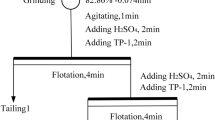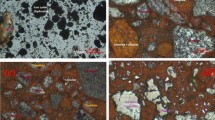Abstract
Detailed characterization study is the pioneer step for any mineral beneficiation scheme. A series of mineralogical and peterographic studies coupled with (Brunauer–Emmett–Teller) surface area, (atomic force microscopy), (laser diffraction particle size analyser), FTIR (Fourier transform infrared spectroscopy), contact angle measurement, zeta potential were carried out, and the findings about the mineralogical and physico-chemical nature of the sample have been described. This paper provides a guide on the proper selection of beneficiation route for iron ore with complex mineral assemblage (Hematite–Goethite–Laterite–Quartz–Kaolinite–Gibbsite). The beneficiation method, especially froth flotation process, potential after a thorough characterization is suggested analysed and the successful upgradation by froth flotation route is envisaged. Flotation results indicated that it is possible to achieve high grade iron concentrate along with lower silica, and alumina content providing a specific reagent regime/system for specific mineral assemblages.
















Similar content being viewed by others
References
Patra S, Pattanaik A, Venkatesh A S, and Rayasam V, J Geol Soc India93 (2019) 443.
Quoicoe I, Nosrati A, Skinner W, and Mensah A J, Chem Eng Sci98 (2013) 40.
Das B, Mishra B K, and Prakash S, Int J Miner Metall Mater17 (2010) 675.
Dash D, Pradhan S S, and Jena M S, J Soc Geosci Allied Technol (SGAT Bull) 13 (2012) 114.
Indian Mineral Year Book, Indian Bureau of Mines, Nagpur (2017).
Vidyadhar A, Singh A K, Srivastava A, Nayak B, Rao K V, and Das A, in Proceedings of the XI international seminar on mineral processing technology, Jamshedpur (2010), p 583.
Jena M S, Sahu P, and Pradhan S S, Ann Tech J Inst Eng (India) Odisha State Centre56 (2015) 246.
Nayak N P, Int J Eng Innov Technol (IJEIT)3 (2103) 109.
Rath S S, Sahoo H, Das B, and Mishra B K, Miner Eng69 (2014) 57.
Sahoo H, Rath S S, and Das B, Sep Purif Technol136 (2014) 66.
Pattanaik A, and Rayasam V, Colloid Interf Sci Commun25 (2018) 41.
Klein C, and Hurlbut Jr C S, Manual of Mineralogy, 20th ed., Wiley, New York (1985).
Lv X, Huang X, Yin J, and Bai C, ISIJ Int51 (2011) 1432.
Hair M L, J Non-Cryst Solids19 (1975) 299.
Verdonck L, Hoste S, Roelandt F F, and Van der Kelen G P, J Mol Struct79 (1982) 273.
Gadsden J A, Infrared Spectra of Minerals and Related Inorganic Compounds. Butterworths, London (1975).
Cornell R, and Schwertmann U, The Iron Oxides: Structure, Properties, Reactions, Occurrences and Uses (2003).
Subramanyan T V, and Natarajan K A, Trans Indian Inst Met41 (1988) 255.
Bickmore B R, Nagy K L, Sandlin P E, and Crater T S, Am Miner87 (2002) 780.
Montes S, and Montes-Atenas G, Miner Eng18 (2005) 1032.
Cases J M, and Villieras F, Langmuir8 (1992) 1251.
Iveson S, Holt S, and Biggs S, Int J Miner Process74 (2004) 281.
Smart R S C, Amarantidis J, Skinner W M, Prestidge C A, La Vanier, Grano S R, Top Appl Phys85 (2003) 3.
Joanny J F, and De Gennes P G, J Chem Phys81 (1984) 552.
Mishra B K, Reddy P S R, Das B, Biswal S K, Prakash S, and Das S K, November issue, Steel World (2007), p 34.
Patra S, Pattanaik A, Rayasam V, Can Metall Q58 (2019) 28.
Thella J S, Mukherjee A S, and Srikakulapu N G, Powder Technol217 (2012) 18.
Dowling E C, Hebbard J, Eisele T C, and Kawatra S K, Proceedings of the XX1 International Mineral Processing Congress, Massaci ed., Elsevier (2000), p 163.
Pattanaik A, and Venugopal R, Adv Powder Technol29 (2018) 3404.
Acknowledgements
The authors are thankful to Dr. M.K. Mohanta, principal scientist, NML-Jamshedpur for his help and support during mineralogical studies and the Central Research Facility of IIT(ISM), Dhanbad, for their support and coordination for the work.
Author information
Authors and Affiliations
Corresponding author
Ethics declarations
Conflict of interest
The authors declare that they have no conflict of interests.
Additional information
Publisher's Note
Springer Nature remains neutral with regard to jurisdictional claims in published maps and institutional affiliations.
Rights and permissions
About this article
Cite this article
Pattanaik, A., Patra, S. & Rayasam, V. Selection of a Viable Upgradation Strategy Through Physico-chemical and Mineralogical Approach: A Case Study of Low Grade Barsua Iron Ore Fines. Trans Indian Inst Met 73, 47–63 (2020). https://doi.org/10.1007/s12666-019-01802-0
Received:
Accepted:
Published:
Issue Date:
DOI: https://doi.org/10.1007/s12666-019-01802-0




